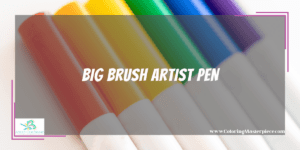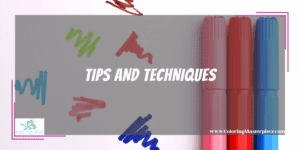If you have a large piece of artwork to fill in, you want to make sure you’re using the right marker for the job. You want something that will give you full coverage and won’t bleed into other page areas.
Best Full-Coverage Markers

Whether it’s a tip that allows for the broad color distribution or color-rich pigment that glides onto the page, each of these eight markers is perfect for coloring in backgrounds and large-scale works. We’ll get a little into tips and techniques to help you get the best results no matter which marker you choose.
Tombow Dual Brush Pens
If you need control in your art pieces, you need Tombow Dual Brush Pens. These pen markers are water-based markers with a brush on one end and a fine tip on the other. They are very popular with calligraphers due to the amount of control they provide. The fine tip end is perfect for writing and creating fine detail, and the brush end can create fine or bold strokes, depending on the amount of pressure you apply. This makes them perfect for coloring large areas as well as more complex applications. The ink produces a watercolor effect with deep, intense colors that are perfect for blending.
Caliart Dual Tip Art Markers
Another dual-tipped marker, Caliart Dual Tip Art Markers, contains alcohol-based ink with a chisel tip on one end and a brush on the other. The waterproof and smudge-proof ink is popular for artists who want to do a lot of blending and color-mixing. Both ends of the markers are equally capable of covering large areas effortlessly. Because the ink is alcohol-based, remember to work quickly since it will be much more challenging to blend away streaks once it dries.
Copic Wide Markers
It’s hard to read an art blog or article about markers without hearing the Copic name, so if you want a marker with a strong reputation, this is it. Copic Wide Markers are made explicitly for large-scale works and coloring in backgrounds, so you’re not going to find a marker better suited to coloring large areas. The alcohol-based ink is refillable, and the pen comes with a replaceable nib, which is a nice additional feature. There’s nothing worse than getting halfway through coloring in the background only to have your marker run dry, so be sure to fill it up before any large project.
Artist Paint Pen
Artistry Paint Pens are not only great for coloring large areas, but they’re also great for coloring on a wide variety of surfaces. The acrylic ink creates vibrant colors on light and dark paper and glass, ceramic, and even stone. The medium tip is wide enough to provide coverage when you need it and fine enough to do more detailed work.
Big Brush Artist Pen

The Faber-Castell Pitt Big Brush Artist Pen is for serious marker artists who want their work to stand the test of time. The waterproof ink doesn’t bleed or smudge, and the paintbrush-shaped tip allows for complete control over stroke thickness. This makes the markers super flexible, whether you want to use them to fill in a large background or do something more intricate. These markers work exceptionally well for mixed-media artists.
Zig Posterman Broad Tip Markers
You’re not going to find a marker much bigger than the Zig Posterman Broad Tip Markers. Made mostly with sign artists in mind, these markers are weatherproof and let you color large areas in a short amount of time. Zig’s makes markers with finer tips as well, in case you want to include some detail in your work and don’t want to use multiple types of ink. Although Zig’s Posterman markers are waterproof, they do come off with scrubbing, so keep that in mind when handling, storing and potentially sealing your completed artwork.
Do A Dot Art Dot Markers
Although the name is a bit of a mouthful, Do A Dot Art Dot Markers are unrivaled when it comes to water-based dot markers. If you don’t know what dot markers are, picture the markers you see in any Bingo hall with the round spongy applicator tip. Although mainly marketed for kids, these dot markers can create interesting backgrounds and cover large areas without worrying so much about streaking and evenness because the irregularity is part of the effect. Try these dot markers the next time you want to color a large area but want it to have some texture. The markers are water-based so that you can blend them for exciting results.
Krink Paint Markers
Although their applicators resemble the dot markers listed above, Krink Paint Markers are mop markers that use alcohol-based paint. This paint is opaque and thicker than the water-based ink used in dot markers, resulting in more robust colors and fuller coverage. Used like the dot markers above to make speckled, textured backgrounds, they can also be used more like a considerable paint pen for broad, sweeping strokes. This makes them a favorite among street artists and muralists.
Tips and Techniques

The following are tried-and-true tips to get the best results when coloring large areas with markers.
Alcohol versus Water-Based Inks: Alcohol-based inks tend to blend better than water-based inks, but only when they’re wet. Because they dry quickly, it’s essential to work as fast as you’re able to prevent streaks.
On the other hand, water-based inks can be reactivated with water after they’ve dried and blended then. Be careful when doing this, though, as rewetting and rubbing the paper can cause it to tear or pill.
Want to learn more tricks to a streak-free application? Check out our article HERE on perfecting coloring with markers without streaks.
Pick a Side
Before filling in a large area, decide which side makes the best sense to start on. This largely depends on whether you’re left or right-handed since you won’t want to be dragging your hand through the wet ink. But there might be other factors to consider, depending on what shape the area is and what’s going on in the artwork around it. Whenever possible, it’s best to work in one continuous motion, rather than having to backtrack over areas you’ve already done. This will help prevent streaks and uneven color.
Go All In
On a similar note to the one above about coloring in one continuous motion, commit to coloring the whole area in one go. If you break up the coloring into multiple sessions, the ink in the first session will not blend with the ink from the second, and you’ll end up with apparent patches showing where you stopped and started.
Bleeding Edge Technique
The most important thing to keep in mind when coloring a large area, according to many artists, is to keep the “edge” of the ink wet so that it will blend with the next bit of ink laid down. This means trying to keep your lines close together and move quickly enough that the stroke you’re making slightly overlaps the stroke before it, while the previous stroke is still wet. This can help the area look more like one uniform piece, rather than a bunch of individual strokes piled on top of one another.
Choose a Direction
No matter how much you do to prevent streaks, sometimes they happen. If you choose to use straight lines when coloring, it might be worth coloring in a direction in which the lines will fit. For example, if you’re coloring in a grass field, vertical lines will look more intentional than horizontal ones. If coloring the sky, the opposite will be true. Some artists prefer to color in circles rather than straight lines, finding them more comfortable to blend. They also find any streaks caused by circles better for some subjects than straight lines, such as smoke or treetops.
A Few Last Things to Keep In Mind
To make sure you get the most out of your experience when coloring with markers, keep the following in mind when you start your piece.
-
- Pay attention to the surface your paper is resting on. If there are uneven surfaces, cracks, and even dirt, every imperfection will appear in your artwork.
- If you’re doing more extensive work for coloring a large area, make sure to use new, fresh markers or recently filled refillable ones. Running out of ink halfway through will make it hard to seamlessly cover-up after the fact.
- Markers can be very sensitive to fingerprints, even once it’s dry. Make sure always to handle marker art by the edges or using a piece of tissue.
Other than that, have fun, practice a lot, and have fun experimenting and trying new things.
Let’s get started! Click here to download my free adult coloring eBook and sign up for my email newsletter!
Disclaimer: The information provided by ColoringMasterpiece.com (“The Site”) is for general informational purposes only. All information on the Site is provided in good faith, however, we make no representation or warranty of any kind, express or implied, regarding the accuracy, adequacy, validity, reliability, availability, or completeness of any information on the Site. Under no circumstance shall we have any liability to you for any loss or damage of any kind incurred as a result of the use of the Site or Reliance on any information provided on the Site. Your use of the Site and your reliance on any information on the Site is solely at your own risk. This blog post is for educational purposes only and does not constitute legal advice. Please consult a legal expert to address your specific needs.
Terms and Conditions: https://coloringmasterpiece.com/terms-and-conditions/

